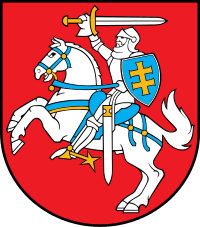Counties of Lithuania
 |
| This article is part of a series on the politics and government of Lithuania |
|
Constitution |
|
Legislature
|
|
|
Politics portal |
The territory of Lithuania is divided into 10 counties (Lithuanian: singular apskritis, plural apskritys), all named after their capitals. The counties are divided into 60 municipalities (Lithuanian: singular savivaldybė, plural savivaldybės): 9 city municipalities, 43 district municipalities and 8 municipalities. Each municipality is then divided into elderates (Lithuanian: singular seniūnija, plural seniūnijos). This division was created in 1994 and slightly modified in 2000. On 1 July 2010, the county administrations were abolished,[1] and since that date, counties remains as the territorial and statistical units.
Until 2010 counties were administered by county governors (Lithuanian: singular – apskrities viršininkas, plural – apskrities viršininkai) appointed by the central government in Vilnius. Their primary duty was to ensure that the municipalities obey the laws and the Constitution of Lithuania. They did not have great powers vested in them, and so it was suggested that 10 counties are too much for Lithuania as the two smallest counties administer only four municipalities. There was a proposal to replace the counties with four or five lands, a new administrative unit, that would be decided according to the ethnographic regions of Lithuania and based on the 5 major cities with the population more than 100,000.
Modern apskritys should not be confused with apskritys that existed in the independent Lithuania during the interwar period. At that time Lithuania had a two-step administrative division: apskritys that were subdivided into valsčius. Lithuania now has a three-step division: counties, municipalities, and elderates (apskritys, savivaldybės, and seniūnijos). See subdivisions of Lithuania for details.
Map
This map shows counties as well as municipalities. Eight city municipalities and two municipalities are marked by numbers:
|
1 – Vilnius city municipality |
4 – Panevėžys city municipality |
7 – Birštonas municipality |

List
| # | County (media help) | Capital | Area in km² (rank) | Population in 2012 [2] | GDP(nominal) total billion EUR in 2012 | Municipalities |
|---|---|---|---|---|---|---|
| 1 | Alytus County (listen • info) |
Alytus | 5,425 (6) | 153,600 | 1.0 |
|
| 2 | Kaunas County (listen • info) |
Kaunas | 8,089 (3) | 596,200 | 6.5 |
|
| 3 | Klaipėda County (listen • info) |
Klaipėda | 5,209 (7) | 333,100 | 4.0 |
|
| 4 | Marijampolė County (listen • info) |
Marijampolė | 4,463 (8) | 157,900 | 1.1 |
|
| 5 | Panevėžys County (listen • info) |
Panevėžys | 7,881 (4) | 244,300 | 2.0 |
|
| 6 | Šiauliai County (listen • info) |
Šiauliai | 8,540 (2) | 293,100 | 2.5 |
|
| 7 | Tauragė County (listen • info) |
Tauragė | 4,411 (9) | 107,200 | 0.7 |
|
| 8 | Telšiai County (listen • info) |
Telšiai | 4,350 (10) | 148,800 | 1.3 |
|
| 9 | Utena County (listen • info) |
Utena | 7,201 (5) | 147,400 | 1.0 |
|
| 10 | Vilnius County (listen • info) |
Vilnius | 9,729 (1) | 806,100 | 12.7 |
|
See also
- Administrative divisions of Lithuania
- Municipalities (Lithuanian: plural – savivaldybės, singular – savivaldybė)
- Elderships (or wards) (Lithuanian: plural – seniūnijos, singular – seniūnija).
- Seniūnaitija (sub-eldership)
- Cities (Lithuanian: plural – miestai, singular – miestas)
- Towns (Lithuanian: plural – miesteliai, singular – miestelis)
References
- ↑ "Dėl apskričių viršininkų administracijų likvidavimo". Seimas of the Republic of Lithuania. Retrieved 21 August 2011.
- ↑ "Lietuvos statistikos departamentas". Department of Statistics to the Government of the Republic of Lithuania. 2015-01-16.
| |||||||||||||||||||||||||||||||||||||||||||||||||||||||||||